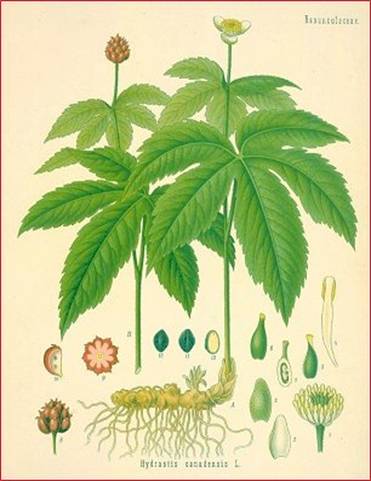

Oxytocics. Martindale's
24th.
Compiled by Ivor Hughes.
Vegetable
Oxytocics
Hydrastis
(B.P.C. 1949). Hydrast.; Golden Seal; Yellow
Root.
Dose:
0.6 to 2 g. (10 to 30 grains)
Foreign
Pharmacopoeias: In Belg., CM., Egyp.,
Mex.
and U.S.N.F. specify not less than 2-5% of anhydrous ether-soluble
alkaloids.
Dose:
30 to 120 mg. (� to 2 grains). Span. P. includes a dry extract containing
10% of hydrastine.
Prepared
by percolation with alcohol (60%) and adjusted to contain 2% w/v of
hydrastine.
Dose:
0.3 to 1 ml. (5 to 15 minims).
Liquid extract of Hydrastis 10 ml., alcohol
(60%) to 100 ml. It contains 0:2% w/v of hydrastine.
Dose:
Liquor
Sedans (Parke, Davis).
A flavoured mixture containing in each fl. oz. the equivalent of 30 m. of
Hydrastis liquid extract (as hydrastine), black haw 60 gr., and Jamaica
dogwood 30 gr., with aromatics. A uterine sedative for
dysmenorrhoea.
Dose:
30 to 60 minims.
The dried leaflets of
Rubus idaeus (Rosaceae).
It contains a principle, readily extracted with hot water, which relaxes
the smooth muscle of the uterus and intestine of some animals. Raspberry
tea is a traditional remedy for painful and profuse menstruation and for
use before and during confinement to make parturition easier and speedier.
The
dosage
which has been used is from 10 to 20 fl. oz. of a 5% infusion of the dried
leaves in hot water in wineglassful doses twice or thrice daily. The
infusion is also used as an astringent gargle.
A preliminary investigation of the active principles of raspberry leaf.�
A. H. Beckett et al, J. Pharm. Pharmacol, 1954, 6, 785.
Dose:
2 tablets every four hours commencing 24 hours before expected onset of
period or labour and continued for 24 hours after onset.
Dose:
1 to 2 g. (15 to 30 grains).
The dried root-bark of Viburnum prunifolium (Caprifolioaceae;),
containing not less than 14% of alcohol (70%)-soluble extractive.
Foreign Pharmacopoeias: In Chil., Cz., Fr.,
Mex., Span., and Swiss. Also in U.S.N.F. Span, and Swiss specify
stem-bark. Mex. and U.S.N.F. specify the bark of the root or stem of V.
prunifolium or V. rufidulum.
Uses.
Viburnum has been used in dysmenorrhoea and for its supposed sedative
effect on the uterus. A survey of the evidence
concerning the activity of Viburnum remedies and suggested methods for
evaluation.�R. A. Woodbury, Drug Standards, 1951, 19, 143.
Liquid
extract of Viburnum 12-5 ml., compound tincture
of cardamom 7-5 ml., aromatic elixir to 100 ml.
Dose:
Compound Elixir of
Viburnum Prunifolium.
Liquid extract of Viburnum 50 ml., liquid extract of Hydrastis 8.33 ml.,
coriander oil 0.42 ml., caraway oil 0.42 ml., glycerin to 100 ml.
Dose:
Dose:
200 to 500 mg. (3 to 8 grains).
Dose:
Usual
dose:
4 g. (60 grains).
Uses.
Viburnum opulus has been used in conjunction with other drugs in the
treatment of functional uterine disorders, but evidence of its therapeutic
activity is conflicting.
See also: Ergot.
If you did not find what
you were seeking, use the site search box at the top right hand of the
page or peruse the site library.
![]()